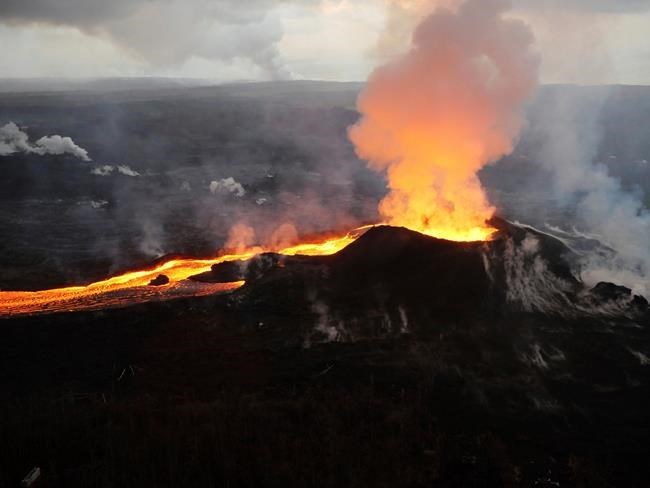
FILE - In this July 14, 2018 photo provided by the U.S. Geological Survey, lava from Kilauea volcano erupts in the Leilani Estates neighborhood near Pahoa, Hawaii. Scientists have downgraded the alert level for Hawaii's Kilauea volcano in response to reduced activity, saying the next eruption is likely a few years away. The U.S. Geological Survey's Hawaiian Volcano Observatory announced Tuesday, March 26, 2019, that the alert level for the Big Island volcano has been lowered from "advisory" to "normal," the Hawaii Tribune-Herald reported. (U.S. Geological Survey via AP, File)
Republished March 28, 2019 - 9:38 AM
Original Publication Date March 28, 2019 - 6:56 AM
HILO, Hawaii - Scientists have downgraded the alert level for Hawaii's Kilauea volcano in response to reduced activity, saying the next eruption is likely a few years away.
The U.S. Geological Survey's Hawaiian Volcano Observatory announced Tuesday that the alert level for the Big Island volcano has been lowered from "advisory" to "normal," the Hawaii Tribune-Herald reported .
The volcano has returned to a non-eruptive, state following the eruption in the lower East Rift Zone that began last May, according to the observatory. Lava flows from the eruption destroyed more than 700 homes and covered nearly 14 square miles (36 square kilometres).
"Monitoring data over the past eight months have shown relatively low rates of seismicity, deformation, and gas emission at the summit and East Rift Zone including the area of the 2018 eruption," the observatory said in a notice.
The volcano's surface has not had active lava for those eight months, marking the longest period without an eruption in nearly four decades, the observatory said. The volcano went 17 months without an eruption starting in November 1979.
Seismic activity remains low, but the number of earthquakes occurring weekly is above levels before the 2018 eruption. The Observatory said most are aftershocks of the magnitude 6.9 quake that hit on May 4, 2018.
Based on past observations, the next eruption will likely be in the caldera, the observatory said. The next eruption in the rift zone could be in a decade or longer.
___
Information from: Hawaii Tribune-Herald, http://www.hawaiitribune-herald.com/
News from © The Associated Press, 2019